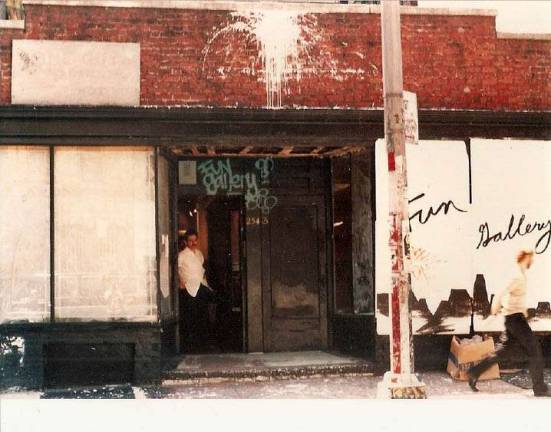L.E.S. Poet Remembers Bygone Gallery Scene

"This whole neighborhood was fabulous for collaboration," he says, sipping a glass of red wine at a corner café on East 12th Street, a few doors down from the building where he still lives. If Masters is somehow suddenly out of place, he either doesn't know it or doesn't show it. This is his chosen 'hood, for better or worse, and it's where he belongs. If there's some longing for an era gone by, it's less about nostalgia than a powerful impulse to preserve the memories and sensibilities of a very special time and place-a poet's desire to capture a singular moment.
Capturing an Era in Print
To that end, Masters has published For the Artists: Critical Writings, Volume 1 (322 pp., Crony Books), the first installment of a two-volume collection of essays, reviews and artist interviews from his years as a writer and critic for Arts Magazine and Cover, two erstwhile publications devoted to the Manhattan arts scene. The book, to be sure, is true to its title: it is a collection of writings for the artists, and if anything is clearer than Masters' admiration for his subjects' efforts, it is his fealty to the collaborative quality of the community they fostered.
The artists interviewed in the book's first third include the filmmaker/photographer Rudy Burkhardt, the painters Sam Messer, Jean Holabird, Elizabeth Murray and Larry Rivers, among others. Strictly speaking, these weren't all "East Village artists" but it's immediately apparent how close-knit the community was, and how intertwined the literary and art worlds really were.
It's not all a big collaborative love fest. Masters draws out the edges in some of these edgy characters. "I like poets as long as I don't have to go their readings," says Holabird. Murray rails against Ronald Reagan and Georgia O'Keefe. Rivers, for his part, is grumpy about a number of things, and doesn't think much of Murray's work.
What little actual criticism appears in the volume is reserved for a disparate group of politicians and art critics of the era-from Presidents Reagan and George H. W. Bush to the art critic Hilton Kramer and other familiar names from the political and art establishments of the period. In his introduction to his interview with Larry Rivers, Masters writes, "it was surprising to find his manner more like a grown-up street kid from the Bronx than an established, world-class artist." But Rivers is hardly the only one among his subjects depicted as a bit surly, angry, combative, perhaps even a little paranoid-exactly the sorts of characters one would expect to find at the heart of a burgeoning art scene.
A Changed Neighborhood
Masters looks out the café window across Avenue A, recalling the East Village as he first met it. "It was a working class, immigrant neighborhood, and a lot of artists moved in because it was poor and affordable. You look at photographs from that era and you can see entire blocks had been decimated."
Then, as if working through the chronology for a documentary, he says, "Patti Astor had the Fun Gallery on East 10th Street. They showed graffiti artists, Fab 5 Freddy, and Jean-Michel Basquiat. As I recall, she was one of the first, and it was a very exciting scene that brought a whole new community to this neighborhood."
"These young artists," he continues, "these graffiti guys who had been painting trains were given gallery exposure and a whole new legitimacy."
He drains the last few drops from his glass.
"And then the limos started showing up."